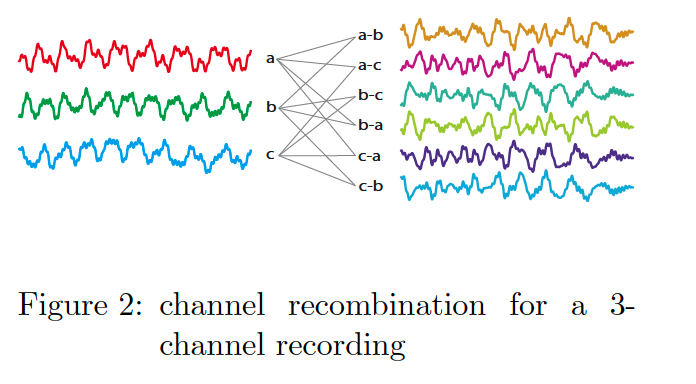Contrastive Representation Learning for EEG Classification
Contents
- Abstract
- Introduction
- Method
- Channel Recombination & Preprocessing
- Channel Augmentations
- Learning Algorithm
0. Abstract
Interpreting and labeling EEG : challenging
SeqCLR ( Sequential Contrastive Learning of Representations )
Present a framework for learning representations from EEG signals via contrastive learning
-
recombine channels from multi-channel recordings
\(\rightarrow\) increase the number of samples quadratically per recording.
-
train a channel-wise feature extractor
- by extending the SimCLR to TS
-
introduce a set of augmentations for EEG
1. Introduction
Presenting a new framework that allows us to ..
- (1) combine multiple EEG datasets
- (2) use the underlying physics of EEG signals to multiply the number of samples (quadratic increase)
- (3) learn representations in a self-supervised manner via CL
Details
- Modify the SimCLR framework for TS
- In contrast to images, not clear what augmentations could be beneficial for TS
- consulted EEG researchers to select a set of transformations

2. Method
(1) Channel Recombination & Preprocessing
we obtain \(n \times (n-1) + n = n^2\) new channels for \(n\)-channel recording

(2) Channel Augmentations
A key ingredient of CL = augmentations
we chose the transformations as…

Strength of each transformation :

(3) Learning Algorithm
SeqCLR ( Sequential Contrastive Learning of Representations )
- like SimCLR, contains 4 modules

-
Channel Augmenter
- for each channel, the module randomly applies 2 augmentations
- \(N \rightarrow 2N\) augmented channels
-
Channel Encoder
-
transforms an input channel into 4 feature channels of same length
-
enables us to encode sequences of different lengths for different downstream tasks
-
designed 2 encoder :
-
(1) A recurrent encoder
- with a multi-scale input ( using down & up sampling of the channel )
- uses 2 recurrent residual units
-
(2) A convolutional encoder
-
utilizes reflection paddings
( to ensure the output signal is of the same length as the input signal )
-
uses 4 convolutional residual units
-
-
-
-
Projector
-
recurrent projection head
- collapses the output of the encoder into 32-dim
- uses downsampling & bidirectional LSTM units
-
-
Contrastive Loss
- identical to NT-Xent ( in SimCLR )
- \(\ell_{i, j}=-\log \frac{\exp \left(\operatorname{sim}\left(\boldsymbol{z}_i, \boldsymbol{z}_j\right) / \tau\right)}{\sum_{k \neq i}^{2 N} \exp \left(\operatorname{sim}\left(\boldsymbol{z}_i, \boldsymbol{z}_k\right) / \tau\right)}\).
-
Classifier
- ( for downstream cls task ) discard the projector & use classifier
- details
- output dim = # of classes
- log softmax
